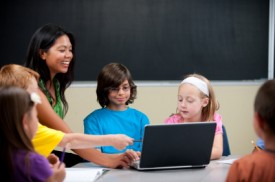
For an educator, getting to know each learner is like experiencing a new book. Every child—every mind that comes into the classroom—represents a new discovery with every turn of the page, their own way of seeing and experiencing the world, and they each bring a unique library of experiences, hopes, fears and dreams.
Now, while that makes for a poetic discussion about the wonderful variety among students, it also makes for a practical challenge in helping every one of these individuals achieve their greatest potential. How can an educator present information such that all of these learners—with all their different world views and brain wirings—will get the most out of the school experience?
Researchers have generated multiple models of the mind, each providing its own way of understanding how we can conceptualize and leverage learning differences in the classroom. Such categories are simply ways for us to classify students and ensure that we are reaching every one as effectively as possible.
All these models strive to answer one single question: How does each individual learner experience and process the world around them? Academics have spent great energies on unlocking these secrets and developing models of how we learn. A quick trip through just a few of these theories (and there are many other theories out there) gives us an idea of the breadth of ideas posed by experts of note since the 1980s:
- David Kolb described four types of learners: convergers (who develop abstract concepts and then actively experiment), divergers (who experience the world and then reflect on their observations), assimilators (who develop abstract concepts and then observe and reflect), and accommodators (who experience the world and then actively experiment).
- Honey and Mumford labeled learners as activists, reflectors, theorists and pragmatists.
- Anthony Gregorc described how people perceive the world in two ways (concrete and abstract) and order the world in two ways (random and sequential), and developed a model with four learner types based on the possible combinations of these qualities.
- Fleming’s model described learners as visual, auditory, read-write or kinesthetic, classifying learners by the kind of information that they most effectively assimilate.
- Howard Gardner described eight different “intelligences,” including linguistic, logical/mathematical, spatial, bodily/kinesthetic, musical, interpersonal, intrapersonal and naturalist.
In looking at these frameworks as a group, they all converge in certain ways and diverge in others. But one element remains consistent throughout, and that is the motivation for having them in the first place. There is a clear practical need for such frameworks in the classroom. Education is not a one-on-one teacher/learner proposition. As much as we would like, we as educators simply cannot provide fully individualized instruction for every student in a classroom of twenty or thirty.
The art and science of classifying how the human brain processes and learns is and will constantly change as we discover more and more about how the brain works. Whichever model or models are applied in the classroom (and again, the best educators will have a deep enough command of each of these models to leverage the best of each), it is up to educators to ensure that each learner is developing and cultivating the same set of core, fundamental cognitive skills: memory (the ability to store information), attention (the ability to focus on tasks and filter out distractions), processing (how fast a student can perceive and manipulate information), and sequencing (how accurately a student can order information). These four key cognitive skill sets, when developed together, have been demonstrated to improve learning and reading. Thus, any teaching we do based on learner classifications must support the development of these skills.
That said, if these classifications add power and efficiency to the way we impart these skills to our students and classes, then we should make use of them as much as possible. In the end, any tricks we can use, any knowledge we can leverage, any technique we can employ—if the research demonstrates it to be effective—represents a valid bit of knowledge that we can use to help our students succeed.
Learn more about the four essential cognitive skillsof memory, attention, processing, and sequencing. For further reading:
Kolb, D. A. 1984. Experiential learning: Experience as the source of learning and development. New Jersey: Prentice-Hall.
Honey, P & Mumford, A, (1982). The Manual of Learning Styles. Maidenhead, UK: Peter Honey Publications.
Mills, D. W. (2002). Applying what we know: Student learning styles. Retrieved May 22, 2011.:
Gardner, Howard (1983; 1993) Frames of Mind: The theory of multiple intelligences, New York: Basic Books. Second edition published in Britain by Fontana Press.
Related Reading:
Inspiring Students to Dream, Learn and Grow
AMPing Up Our Teaching to Increase Intrinsic Student Motivation

